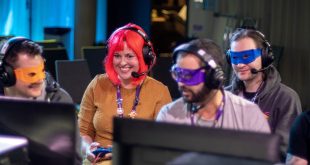 by Giovanni Petrantoni, CEO and Founder at Fragnova
by Giovanni Petrantoni, CEO and Founder at Fragnova
In 2021, media headlines were dominated by non-fungible tokens (NFTs) selling for millions of dollars. Whether you liked or loathed the fact that an NFT of the doge meme could fetch $4m or digital images of pixelated aliens such as those in the CryptoPunk collection were selling for over $10m, the general consensus was that NFTs are here to stay, and people were willing to spend a lot of money on them.
Just in case you don’t know, NFTs are unique cryptographic tokens that can be tied to objects such as music, media content, in-game items, or maybe providing certain perks in real life such as exclusive access to events. Ownership of these tokens is stored in a blockchain (usually tied to the Ethereum network), allowing them to be sold and traded for cryptocurrency. The hype behind NFTs eventually caught the attention of the wider video game industry, but gamers have been fiercely critical of any such plans. That’s because the game industry’s adoption of NFTs so far has been completely pointless and in most cases, nothing more than an obvious cash-grab.
When Ubisoft announced it was launching its Quartz plan with in-game NFTs (Digits) available through Ghost Recon Breakpoint, gamers were incredibly vocal about how much they hated this idea (69% of gamers hate NFTs, according to Fanspot). When Team17 and GSC Game World announced their NFT plans for Worms and S.T.A.L.K.E.R. 2 this year, the backlash from both gamers and games media was so significant they were abandoned entirely. This is what happens when you try and rush through new ideas into established game franchises that add absolutely no value to their players or the teams that build them.
It’s not just gamers pushing back against NFTs. Minecraft’s creator, Mojang Studios, recently published a statement saying that NFT integration is something that they’ll “never support or allow” NFTs in Minecraft, although it didn’t completely rule out using blockchain technology in the future, as Mojang Studios will continue to monitor this to see if it will ever “allow for more secure experiences or other practical and inclusive applications in gaming.”
A lot of the scepticism and criticism of NFTs was due to the fact that many people believed the NFT hype was just a huge bubble waiting to burst. Prices have been declining steadily since the beginning of this year, with NFT sales experiencing a 92% decline from its peak of 225k sales in September 2021. Couple this with the crumbling crypto market where the biggest currency, Bitcoin, has lost around 58% of its value in Q2 2022, and you can see why Team17 and GSC Game World might have dodged a bullet.
Of course, there are plenty of other reasons the wider gaming industry is so critical of NFTs, and I say the wider gaming industry because web-based games such as CryptoKitties and Axie Infinity have been utilising NFTs, blockchain technology and cryptocurrency since 2017, only they never made a big song and dance about calling them NFTs and weren’t heralding their games as the future of the industry.
The NFTs for Cryptokitties and Axie Infinity are virtual pets and monsters, so they actually had a viable use as the core gameplay mechanics for both Cryptokitties and Axie Infinity focus on trading, breeding and battling (in the case of Axie Infinity) Kitties and Axies. That hasn’t stopped either of the games from crashing, though, especially the value of Axie’s cryptocurrency Smooth Love Potions, which is used to breed new Axies.

Unfortunately, blockchain technology has been a casualty of the NFT crossfire. As the data (usually just the metadata, very rarely more) for NFTs is stored in a blockchain ledger, many people see NFTs and blockchain as being completely indistinguishable. Ultimately, this means that when people think about blockchain, they also think about NFTs and immediately think, ‘oh, this is going to be a scam,’ or, ‘it’s going to create value that doesn’t have any utility.’
This is a shame, as there are plenty of viable uses for blockchain technology within the video game industry, especially as blockchain technology (when it’s used correctly) can be one of the most efficient ways of embracing the creator economy and ensuring creators get paid for their work. Let me explain. The complex ownership structures and rights agreements that exist within the video games industry can make managing rights and royalty payments challenging. These processes are also incredibly lengthy. As an example, it used to take Microsoft Xbox 45 days to distribute royalties to its partners. Now, this process only takes four minutes, thanks to the Smart Contracts deployed through the blockchain technology they implemented back in 2020.
So, Microsoft Xbox has been utilizing blockchain technology to ensure game creators are paid more efficiently, but mention blockchain to gamers in 2022 and the first thing that most people will assume is you’re trying to sell them NFTs or cryptocurrency. Now that the NFT bubble has burst and the static noise from crypto enthusiasts has dissipated, there’s an opportunity for the wider video game industry to tap into the full potential of blockchain technology and see its value. Current NFT standards are poor, and they’ve failed to evolve and expand their utilities over the years, utilities that are essential to make these digital assets relevant to game development. As it stands, the backlash from gamers toward NFTs is justified because they offer no use other than being a very expensive digital collectable.
With these poorly implemented uses of NFTs out of the picture, I hope it opens up an opportunity for gaming audiences to educate themselves on the use cases for blockchain technology within video games, and understand that the words blockchain, NFTs and cryptocurrency can be completely separate from each other. Using decentralised systems will create a gaming environment for creators that provides ownership and the right tools to establish new forms of monetisation, independent of closed systems.
The long-term vision for the ecosystem we’re creating at Fragnova is to allow payments to distribute royalties to other people involved in game development through our improved contracts, such as artists and designers. One example of this will be seen through any mods that are sold through the Fragnova marketplace in the future. As well as the creators (directly or indirectly involved) of these mods being able to take payment, the original game’s creators will also take a cut of any mods sold that have been created for their game(s).
Ultimately, we believe the future of the video game industry is in the hands of the creator community, facilitated by a decentralised asset store that allows them to trade scripts, 3D models, audio, games, in-game items and so much more. There’s a reason why companies such as Epic are rolling out creator tools for games like Fortnite; they recognise the important role that creators and developers play in shaping its future.
We want to facilitate that same vision but at a wider level through the Fragnova network, allowing everyone to access and share the tools they need to do this. Yes, this will involve blockchain technology, as it’s the most efficient way of not only keeping track of this information but ensuring the creators of these tools are fairly compensated. More importantly, it will prove that blockchain technology has a viable use within video games and there doesn’t have to be a Bored Ape or Doge in sight!

 MCV/DEVELOP News, events, research and jobs from the games industry
MCV/DEVELOP News, events, research and jobs from the games industry




